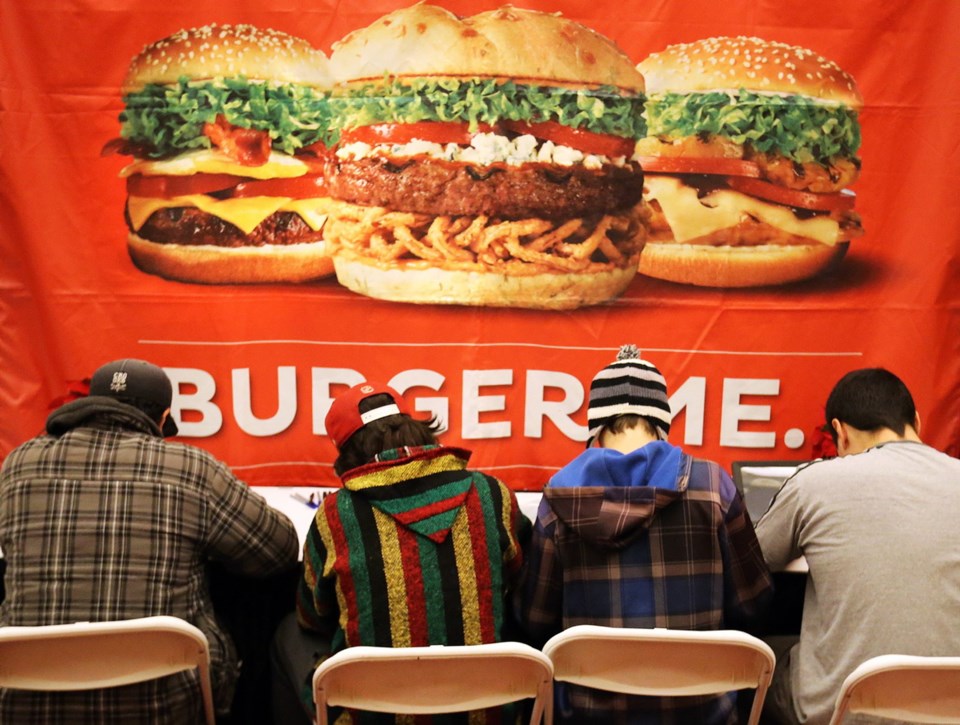April Harkness is educated, experienced and has two jobs with great companies, but she still doesn’t make more than $25,000 a year.
“I’m always in the red,” said Harkness, 36. The single mother of a six-year-old son lives in Colwood. She works downtown as a receptionist in a high-end spa and also as a flight attendant.
But both jobs are part-time and on call. Though she manages to cobble together almost full-time work, she can’t take every shift she’s offered if she doesn’t have childcare for her son.
“If my ex isn’t available, then my parents have to come down from Duncan and help,” said Harkness, who has an associate arts degree, hospitality diploma and 10 years’ experience in the spa and hotel industry. After-school care, child support and a rental subsidy help her get by, but she’s still barely making ends meet.
“It’s embarrassing to be a 36-year-old woman with a great education and experience and be in this situation,” she said, pointing to a lack of decent-paying full-time jobs in Victoria that value experience as well as education.
Read the Hidden Poverty series
- Introduction: The growing problem of hidden poverty in Greater Victoria
- Part 1: How domestic violence is driving homelessness in Greater Victoria
- Part 2: Childhood poverty and the single-parent trap
- Part 3: The growing concern of the city’s underemployed and underpaid
- Part 4: An aging population in financial limbo and a housing crisis
- Part 5: Small changes coming and big changes needed to address local poverty
“I’m looking at postings all day and they all want an undergraduate degree. … They don’t consider experience,” said Harkness. “To quit the two jobs that I have, I’d need to find something that’s a decent wage.”
While Victoria’s five per cent unemployment rate is one of the lowest in the province, job seekers and advocates say a drastic shortage of well-paid low- to medium-skill jobs is putting people at risk of poverty.
“There is no such thing anymore as medium-pay, low-skill work,” said Randy Waldie, a case manager at WorkLink Employment Society, which provides government-sponsored employment services on the West Shore. “It used to be you could make a living wage in mills, mines, manufacturing or working in a bakery. … Now if it’s low-skill, it’s low pay.”
The employment office has seen a steady increase in job seekers, including the elderly and those with disabilities looking for a way to supplement their income. Waldie said he and his colleagues’ jobs have evolved from helping people with resumés and interviews to working through more social barriers to employment.
“We’ll work with someone for months or even years,” he said.
* * *
Ryan Olson, 19, has been looking for a job for the past year, since he finished high school.
“I go out and hand out resumés because that’s what you’re supposed to do. But everywhere they’re saying they want someone with more experience. … But how can I get experience if I can’t get the most basic job?” Olson said.
He is studying business at Camosun College, with dreams of opening his own restaurant some day. He hoped to gain some work experience while he went to school, applying at local fast-food restaurants and grocery stores.
“Employers are looking for more skills than what you would find out of high school,” said Olson, who was told by one employer they didn’t hire anyone under 20. “And it wasn’t a great job by any standards.”
He said he feels lucky to have some supports, like a rental subsidy and help through the Threshold Housing Society’s program for semi-independent youth, but feels for friends who come out of school with no family and no prospects.
“It’s really hard for youth in this city,” he said.
Jen Harrison, community co-ordinator for WorkLink, said she’s seeing more and more people at job fairs who are looking for second or third jobs.
“They’re not making it on minimum wage or even more,” she said. The average hourly wage on WorkLink’s wall of job postings is $12 to $14. Minimum wage in B.C. is $10.25 an hour. Someone living on basic income or disability assistance might receive about $600 to $1,100 a month — much less than $10 an hour.
In April, Victoria’s estimated “living wage” rose to $18.93 an hour. The number is calculated by the Community Social Planning Council, along with First Call B.C. and the Metro Vancouver Living Wage for Families Campaign. It is based on what two full-time working parents with young children need to earn to meet their basic needs, such as shelter, food and clothing.
* * *
Marika Albert, researcher and program manager of poverty prevention with the council, said minimum-wage and income-assistance rates need to be raised to help the working poor and those stuck in the system.
“[Those rates] are numbers not tied to anything relevant, like the actual cost of living,” she said. “A single parent working full time who can’t make more than $20,000 a year logically can’t raise a child on that. … If people made more money, they would be spending it. We’d have a better economy.”
The widening income gap between younger and older generations over the past three decades has directly affected disposable incomes in Canada and the western world.
According to the Conference Board of Canada, tax records show that between 1984 and 2010, the income gap between men in their early 50s and men in their late 20s grew from 53 to 71 per cent.
For women, the gap grew from nine to 43 per cent. The average disposable income of Canadians between the ages of 50 and 54 is 64 per cent higher than that of those between 25 and 29 years old, up from 47 per cent higher.



